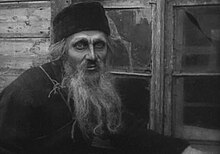Ivan Ilyich Mosshuchin
Iwan Iljitsch Mosschuchin ( Russian Иван Ильич Мозжухин , scientific transliteration Ivan Il'ič Mozžuchin ; in Latin script also Mosjukin , Mosjoukine or Mozzhukhin ; * September 26th July / 8th October 1889 greg. In Penza , Russian Empire ; † 18 January 1889 in Penza , Russian Empire 1939 in Neuilly , France ) was a Russian silent film actor .
Life
He began to play on small stages around 1910 and had his first appearances in films as early as 1911, including as Napoléon III. in The Defense of Sevastopol (Oborona Sevastopolja) , a tribute to the Crimean War of the 1850s from the production of Alexander Khanshonkov . Mosschuchin became the first film star in the Russian Empire , benefiting from his talent for aloof elitist game. In the 1910s he worked with all the major Russian directors ( Pyotr Tschardynin , Jakow Protasanow , Alexander Volkov , Evgeni Bauer ). Under Protasanov he played his most successful roles in Queen of Spades ( Pikowaja dama , 1916) and Father Sergius ( Otez Sergei , 1918).
In 1919 he emigrated from Soviet Russia to France via Turkey . He appeared in films in the Weimar Republic and France in the 1920s . Mosschuchin was also the screenwriter of several of his films and delivered his only directorial work in 1923 with Le brasier ardent . He met Jean Epstein through the group of Russian exiles at the production company Les Films Albatros and in 1924 they made the adventure film Le lion des Mogols together . Volkov, who also emigrated to Western Europe, cast Mosschuchin in Kean in 1924 , a role he played in the theater as early as 1911, and in the title role of the Franco-German co-production Casanova in 1926 . This film is one of the early documents in color film . The French director Marcel L'Herbier , known for his avant-garde films, filmed The Two Lives of Mathias Pascal in 1925 based on a novel by Luigi Pirandello , which is important today primarily through the portrayal of Ivan Mosschuchin.
With the advent of talkies, Mosschuchin's career came to an end because his heavy accent was not accepted by the audience. He made his last film in 1936. When he died, he was 49 years old and impoverished. Ivan Mosschuchin was one of the first male film stars in Europe.
He liked to describe himself as descending from Circassians , which cannot be confirmed. The Lithuanian-French successful writer of the 1960s / 70s Romain Gary referred to Mosschuchin as his father all his life, which is definitely fabulous, like most of what Gary said about his vita.
His first wife was Nathalie Lissenko , a Russian actress. The second wife was a Danish actress Agnes Petersen .
In an experiment by the filmmaker and film theorist Lev Vladimirovich Kuleschow , who ran a film workshop shortly after the Russian Revolution , he re-assembled an identical shot of Mosschuchin three times from existing film material: once with a plate of soup, then with a woman in a coffin and with a little girl . Afterwards, the audience was enthusiastic about Mosschuchin's subtle and affective ability to “convey such different emotions as hunger, sadness and affection” ( Kuleschow effect ).
Films (selection)
- 1911: The defense of Sevastopol
- 1913: The house in Kolomna
- 1914: Schisn w smerti
- 1915: Ruslan and Ludmilla
- 1916: Queen of Spades
- 1916: Kulissy ekrana
- 1917: The merry Satan
- 1917: Father Sergius (Otiez Sergej)
- 1922: Kean
- 1922: The mysterious house
- 1923: Marriage stories
- 1924: Le lion des Mogols
- 1925: The two lives of Mathias Pascal
- 1926: Michel Strogoff - The Tsar's Courier
- 1927: Casanova (Casanova)
- 1927: Surrender
- 1928: The secret courier
- 1928: The Tsar's adjutant
- 1929: Manolescu
- 1930: the white devil
Web links
- Ivan Mosjoukine in the Internet Movie Database (English)
- Jürgen Keiper: Ivan Mosjukin. In: German Film Institute (DIF). Archived from the original on August 29, 2006 .
- Pictures by Iwan Ilyich Mosschuchin In: Virtual History
Individual evidence
- ↑ James Monaco : Understanding Film. Art, technology, language, history and theory of film and the media. With an introduction to multimedia (= Rororo 61433 rororo-Sachbuch. Rororo-Film ). Special edition. Rowohlt-Taschenbuch-Verlag, Reinbek bei Hamburg 2002, ISBN 3-499-61433-2 , p. 429.
| personal data | |
|---|---|
| SURNAME | Mosschuchin, Ivan Ilyich |
| ALTERNATIVE NAMES | Mozžuchin, Ivan Il'ič; Mosjukin; Mosjoukine, Ivan; Mozzhukhin, Ivan; Мозжухин, Иван Ильич (Russian) |
| BRIEF DESCRIPTION | Russian silent film actor |
| DATE OF BIRTH | October 8, 1889 |
| PLACE OF BIRTH | Penza , Russian Empire |
| DATE OF DEATH | January 18, 1939 |
| Place of death | Neuilly , France |


